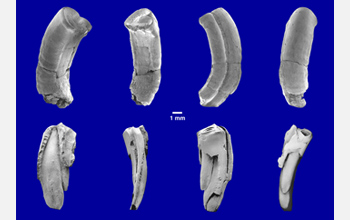Protoceratops
The Protoceratops was a small sheep-sized dinosaur that traveled the land in the upper Cretaceous Period of what is now known as Mongolia. These small herbivores belonged to the Protoceratopsidae family which was part of the larger order of Ceratopsia. The Protoceratops is a relatively primative species of horned dinosaur and doesn’t have particually well developed horns in comparions to other Ceratopsia.
The Protoceratops was first discovered back in 1922 by J.B Shackleford. J.B Shackleford was on a trip to the Gobi desert looking for ancient human ancestors when him and his team came across many fossilized dinosaur specimens.

A artist impression of a Protoceratops
Along with a selection of Protoceratops fossils J.B Shackleford and his team also unearthed specimens of Velociraptor, Oviraptor and another Protoceratopsidae, the Psittacosaurus. One of the most fantastic fossil specimens was unearthed in 1971, Mongolia, this fossil showed a Velociraptor with its limbs wrapped around the Protoceratops leading experts to believe that the two died fighting.
The Protoceratops could grow to a length of around 6 feet and stood on all fours at a height of around 2 feet tall when measured up to the shoulder. Its believed that due to so many specimens found in close proximity that the Protoceratops traveled in herds with each individual weighing in at around 400lbs.

A full Protoceratops skeleton on show
The skull of the Protoceratops was large but still within normal proportions for its size. The Protoceratops had many teeth perfect for ripping its way through dense vegetation and although the Protoceratops were herbivores its believed they could still pack a very powerful bite especially with the aid of its frontal beak.
The Protoceratops’ skull had 4 pairs of holes of which one pair was the eye sockets and others likely being a nose. The frill of the Protoceratops also had two large holes in its neck frill. The neck frill itself would vary in size from individual to individual with some believing that the size was determined by age. It is also thought that the size of the frill may have been a deciding factor when choosing a mate.



protocerotops is not cute animal